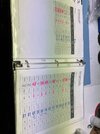Jim Watson
Member
Depending on the powder I got from 25 to 40 fps less with .45 Small.
That wouldn't matter much in factory equivalent loads but if you are loading light target ammo, you could get malfunctions or fail to make power factor. But since that would be with reduced loads, you could make it up with a little heavier powder charge or a small pistol magnum primer.
That wouldn't matter much in factory equivalent loads but if you are loading light target ammo, you could get malfunctions or fail to make power factor. But since that would be with reduced loads, you could make it up with a little heavier powder charge or a small pistol magnum primer.


